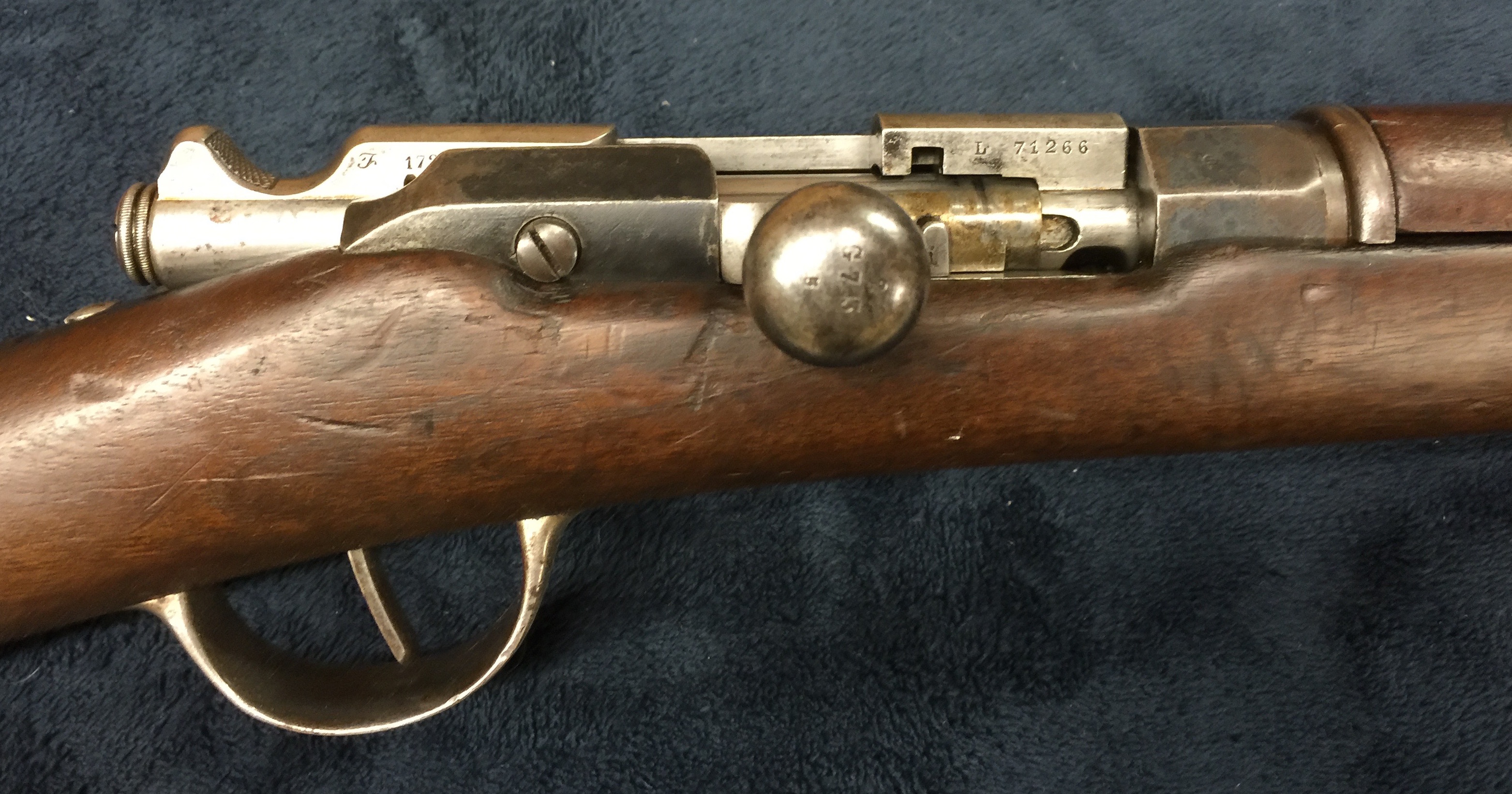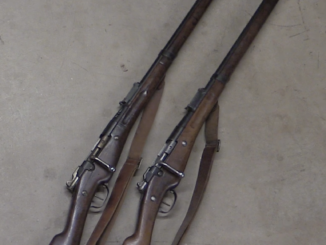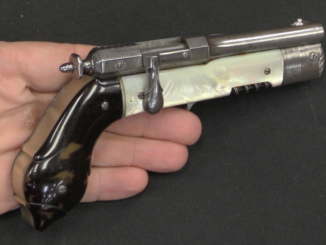Switzerland was an early adopter of the Luger pistol as a standard military sidearm, but by WWII that design was becoming obsolete and the Swiss began looking for a newer sidearm. Several lines of development were pursued, and we have examples of two of them here: the W+F Bern P43 and the SIG P44/8 (the /8 designates the single stack 8-round magazine; there was also a double stack P44/16 made).
These are both mechanically Browning short-recoil tilting barrel pistols, but they do show some significant differences, particularly in the trigger mechanisms. The P44 was developed from Charles Petter’s MAS 35A pistol adopted by the French, and it would go on to become the P47 (aka SIG P210) and the winner of the Swiss handgun trials. As the P210, it is arguably the best quality service pistol ever adopted by any military.
Edit to add: Well, I missed the boat big-time on this one! I don’t have much hands-on experience with the Browning P35 (aka GP, aka Hi-Power) and missed the clear fact that the P43 is in almost all ways a copy of that late Browning design (including the firing mechanism). Whoops!




Like the rest of the pistol, the trigger linkage of the W+F P43 is a straightforward adaptation of the FN GP35 mechanism.
My thought too…
Thanks Ian,
Two very cool Swiss takes on Saive’s and Petter’s respective 1935 takes on the Browning theme.
It’s interesting that though the locking lugs follow Soviet TT33 practice, and the modular hammer mechanism idea is used too, there seems to be no attempt to use the Tokarev idea of putting the hammer spring inside the hammer, and using the space saved to do what Tokarev didn’t… To drop the whole pistol deeper into the hand.
Hi Keith
I am not sure if they were impressed with Tokarev, given time and circumstances, but I definitely agree that Tokarev had it right. The idea as demonstrated in video is superb though.
In contrary, another pistol in same caliber (7.62×25) the Vz.52, by adding up hammer spring behind magazine, makes the heft of grip merely manageable. They should have taken his design and do with it; perhaps with their own cosmetics, if they wanted to.
Hi Denny,
Unfortunately I never got to handle or fire either a Tok or a Vz 52, I’ve always thought both were cool from a distance though. Even if the chamber area is cut a bit thin and the hammer drop safety sometimes results in a negligent discharge on the Vz…
Ergonomics is probably changing, people no longer do manual labour from their teens, and hands are getting smaller.
It would be interesting to know what proportion of the Swiss Ruperts were farmers with hands like shovels, or bank clerks with girlie sized hands… Certainly the pistol which was eventually chosen had a single stack mag.
@ Keith:
‘Unfortunately I never got to handle or fire either a Tok or a Vz 52’
LUCKY YOU. Good advice: if you like to keep liking them, keep admiring them from a safe distance.
The Tok has a grip skinny, and almost rounded, perpendicular to the slide, like a 19th Century European revolvers, which you had to hold with your elbow bent, while the potent round is trying to wrestle it out of your hand on every discharge. BTW of the ND – Tok has got NO safety at all, manual or automatic, except of the half-cock notch, just like a cap-and-ball pistol.
The vz.52 started life as a potentially nice SA/DA handgun in 9 mm Luger, called CZ491. After the ‘Victorious February’ of 1948, when the Commies took over Czechoslovakia, the pistol was burdened with an overly long but ‘solely correct’ 7,62 Tok round, which made it’s grip unwieldy: very flat, very deep, very thin. It actually fits your hand like a fence slat – barely. The DA function was abolished, because the ‘solely correct’ Tokarev pistol did without: ‘- So who are you, Comrade Designer, to come up with this useless feature? You think you know better than the Soviet comrades?’ And so the final prototype CZ513 was not only the soap-bar handled, but SA-only as well. The main features of the original CZ491 survived only in its miniaturized version, the 7.65 mm blowback vz. 50/70.
I have shot both (not to mention the 50/70 as well) quite intensively while researching for articles I wrote on both, and as far as I’m concerned, I’d go for them only if the alternatives were fighting with bare hands or throwing stones.
The form of the Tokarev was copied from the Browning 1907 (I think it was. Or 1909?) used in Scandinavia in Browning Long calibers and as substitute standard by Imperial Russia. That’s how it got that badly pointing grip angle.
Mechanically, the design is an ingenious simplification and improvement of the Browning recoil-operated pistol mechanism. Prewar guns are well made and finished, and during wartime their fit and finish deteriorates far more than German weapons do.
I’ve wondered why the Cz 52, which clearly borrowed a lot from Walther production engineering, was SA only. I agree with the “fence slat” description of its grip. The safety is, as always on postwar Czech pistols, unique and interesting (as is the 50/70).
The Makarov is a Walther PP beefed up to be produced by State Vodka Powered Tractor Works No. 32, but it fits a hand fairly well. The 50/70 is almost exactly PP sized.
“It’s interesting that though the locking lugs follow Soviet TT33 practice, and the modular hammer mechanism idea is used too”
The lucking lug around the circumference were used on 1910 Browning, but because the bbl was too thin and the lower part of the lugs promoted cracks, these were discontinued on final 1911. The Soviets went the other way – at first ground off the lower lugs, but because their bore was much narrower, and the bbl was thus thicker-walled, they finally decided to leave it unmolested and cut down on machining time. So in fact this was not the Tokarev influence, but Browning again.
Also, the first pistol with a complete lift-out trigger mechanism complete with mainspring was the Lewis submission of 1925 for the French pistol contest, not the Tokarev. Both Petter French pistols, the Mle 1935A and Mle 1935S/SM1 had the identical arrangement in 1934. And Petter pistol is the obvious model for the W+F 44/8.
In fact you have 3 french pistol :
Modèle Mle 1935A
Modèle MAS 35S
Modèle MAS 35SM1 (Modification of the safty)
The BHP trigger mechanism….almost exactly!!!
This is a strange video, I’m not sure why the P43 is consistently called a “1911 inspired” handgun when it is clearly a copy of the Browning Hi-Power? Also, unusual trigger mechanism? Nope, almost exact copy of that of the BHP.
Yeah, that is the result of my not having nearly enough exposure to the BHP, and not recognizing the similarities. Embarrassing!
Not Forgotten enough, that BHP 35, evidently.
Gorgeous pieces of work; thanks for showing!
It’s interesting to compare the P43 slide’s reinforcement to the now-discontinued FN HP40 (.40 cal P-35) slide. The two seem very much alike in concept. The built-up part either side of the hammer may have helped in avoiding snagging when drawing it from under clothing, but for a pistol intended to be carried in a full-flap holster it seems a bit odd. Looks nice, though.
The P43 safety is an improvement over the usual P35 safety, which was very small and easy to miss with your thumb in a draw. The magazine floorplate with its thumb and finger grips seems to have been inspired by the Swiss 7.65 Parabellum’s magazine, and would certainly be easier to grasp when wearing gloves.
All in all, the P43 looks a bit “futuristic” even today. I’d buy one if they were still making them. Maybe someone will make a commercial version.
cheers
eon
But eon, wouldn’t the price be a bit on the high side? We are talking about Swiss guns… As for the P43 being futuristic, I wouldn’t be surprised if a space marine whipped one out of his holster and dominated a nitwit who thought stolen blaster pistols were the biggest bangs on the block.
The magazine of the SIG SP44/8 prototype shown is somewhat curious given the crease in the sides of the tube. You generally only see that feature in a single-stack if the magazine is intended for a cartridge smaller than the original chambering. Could the magazine have been meant for a 7.65mm Parabellum variant instead? After all, that was the the issue Swiss service pistol cartridge before the adoption of the P49.
FWIW: The lockwork of the Petter design was a bit of a ripoff from D.J. Saive’s own submissions to the French 7.65mm Long pistol trials.
The W+F prototype was obviously inspired by the FN GP35. However, I wonder if the relocated magazine safety didn’t partially inspire the version that FN used in their GP Competition variant of the early 1980s.
There is a ghost view of the pistol available that makes me wonder if the W+F frame wasn’t fabricated as two halves of a stamping. The interior contours at the bottom of the magazine well would be a bear to machine out of a forging.
There was also nifty variant of the W+F up for auction that dumped the external slide stop for vertically sliding disassembly latches.
The crease in the SP44/8 magazine body was deleted on the SP47/8, which was mostly issued in 9mm Para. It reappeared in the P49 and P210, with the latter more frequently issued in 7.65 Para.
A major difference not noted in the SP44/8 is that the slide rails are not reversed, like they are on the SIG 210 and CZ75 pistols. Instead, we see they are in the more common “outside” configuration. Also, the dual swinging links under the barrel lug are a direct copy of the earlier French 35A. This did not continue into the production of SIG 210.
Similarity between FN GP35 and WF P43 seems unquestionable. But, if noticed, FN GP35 Extractor placement, shape and construction all were assigned by slide mounted Trigger Lever Connector Axis Pin. WF P43 seems quite different than its inspirer.
Strongarm,
I’m wondering which version of the GP35 you’re referencing. The early BHP/FN GP35 models had an internal extractor, and the pivot pin for the trigger transfer bar was easily removable without special tools, by using the end of the slide stop to pull the firing pin, after which the extractor was also easily taken out. Most of these had a thumbnail-shaped cutout further forward on the slide to facilitate removal of the slide stop, and are called “Thumbnail Slides.” I say MOST had this because I’ve seen FN produced models from 1961 for the Buenos Aires Police that had all of the features of early models, but lacked the thumbnail slide cut.
Later models, called “Pinhole Slides”, simplified the machining by using a roll pin crossing from left to right of the slide to retain the trigger transfer bar, and a vertical pin to pivot an external extractor, and deleting the thumbnail cutout as well.
Thanks for your interest in my post Kurt,
The types of FN GP35s are what you desribed; Pistols with inside and outside extractors. As you mentioned, the trigger connector axis pin wih an outside two pinned bridge, closes the location of an outside extractor and therefor needing an interior extractor,
the outside extractor version with a rollpin, gives a downward cant for extractor recess
for secure mountage for that trigger lever connector axis pin(In other case, the two recesse would cross with each other). Both models have reasons to shape and locate the
extractors coming from the presence of said connector axis pin. P43 seems having very
different placement for the extractor and, I confess,I do not understand what its approach is.
I am half wondering if patent considerations didn’t come into play when a decision was made by the Swiss.
What new patents there were from the HP would certainly still be active in ’43 but the 1911 patents would have expired.
Browning’s patent was granted in 1927, and most of its features didn’t carry over to the final GP35. Some have suggested that FN waited to release the pistol so that Saive could add features from earlier Browning designs once Colt’s assigned patents expired.
https://www.google.com/patents/US1618510
What patents did FN have on the gun in addition to Browning’s?
I’m speculating that W+F Bern ended up with a gun the Swiss were reluctant to buy because of the additional costs associated with licensing those patents. At the time FN couldn’t really speak for itself being occupied by Zee Germans. They’d have to be aware that those licenses often come due at the end of hostilities.
I honestly don’t know what kind of patents FN had on the GP35 design outside the US before WW2. To be honest, I’m guessing few given that Petter’s en bloc lockwork was a rip-off of Saive’s other submissions to the French pre-war pistol trials.
FWIW: SIG didn’t have an issue with licensing Petter’s patent.
Actually, Petter was a Swiss citizen, and his patents were taken in Switzerland first, licensed to the French.
What I like about them is captive recoil springs equals quick take down.
I have more 1911 bushing wrenches than I need!
TomTB,
If you really like captive recoil springs in something similar to the 1911, then check out the Star model BKS. It’s a Commander-size 9mmP with an aluminum frame. Slightly thinner than the .45, very well built, easy to conceal and fun to shoot. I’ve owned many. Its only Achilles heel is the firing pin, which can break if dry-fired. Get your gunsmith to fit a BHP firing pin and retainer plate to it and you’re GOLDEN.
Let me know how you like it!